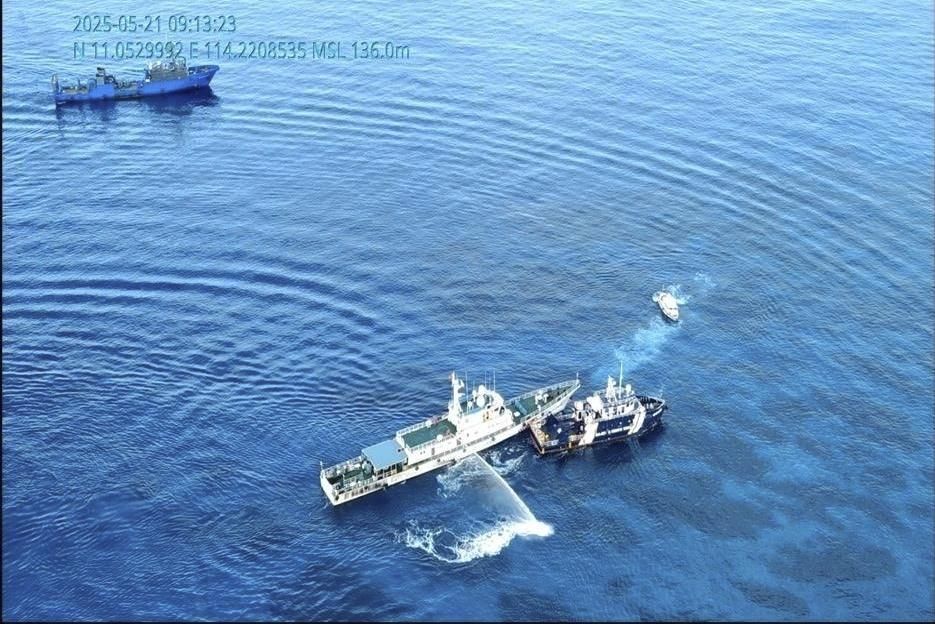
SEOUL, South Korea — Hounded, harassed and bullied by China in the South China Sea, Filipino leaders in Manila are scrambling to cut a deal with Beijing in hopes of avoiding a high-stakes military showdown over contested islands, reefs and even fishing spots off the northern coast of the Philippines.
China’s mounting pressure campaign on yet another key American ally in the region ups the stakes this weekend for U.S. Defense Secretary Pete Hegseth, who is due in Singapore to attend the Shangri-La Dialogue, Southeast Asia’s high-profile annual defense conference, which kicks off Friday.
Mr. Hegseth is expected to again make the case for U.S. allies to stick with the Trump administration, despite tariffs and growing concerns about America’s willingness — or even ability — to counter an expansionist China in the region.
On May 21, a Chinese Coast Guard vessel, roughly twice the size of its target, bore down on a Philippines Fisheries Department vessel, rammed her amidships, then hosed her down with water cannon, point-blank.
Jay Tarriela, spokesperson for the Philippines Coast Guard, condemned “the hostile actions by the Chinese Coast Guard” in a tweet on X, accompanied by footage.
The drama occurred off Pag-Asa Island, or Sandy Cay, the only Philippine community in the Spratly Islands, 276 miles west of the Philippine island of Palawan — where U.S. Marines were exercising early this month — and 646 miles southeast of China’s nearest landmass, Hainan Island.
On May 28, the Philippines returned fire symbolically, staging a public relations victory: Its Coast Guard escorted a convoy of civilians and journalists to a concert on an isle off Palawan.
Three Chinese Coast Guard vessels kept their distance. Chinese state media called the incident a “farce” and a “desperate attempt to grab attention.”
Beijing claims some 90% of the South China Sea, a vast space encompassing commercial shipping lanes, rich fishing grounds and underwater resources. South of China, it is enclosed by Southeast Asia nations east, west and south.
But while the sea’s myriad — and inherently valuable — maritime features are claimed by multiple nations, only two are actively confronting Beijing.
Vietnamese forces have clashed with China’s shjips, but currently, most confrontations are off the Philippines.
A bilateral agreement was reached last year to address China’s concerns about a makeshift Philippine base — the grounded hulk of a World War II-era vessel, the Sierra Madre. But elsewhere, tensions constantly flare and fade over reefs, atolls and fishing grounds.
In Manila, worried politicians are looking for a deal.
“We underscore the urgent need to accelerate the adoption of a legally binding code of conduct in the South China Sea,” Philippines President Ferdinand Marcos Jr. told the 46th Association of Southeast Asian Nations Summit in Malaysia this week. “This is to safeguard maritime rights, promote stability, and prevent miscalculations at sea.”
Concerns are that a Philippines–China incident could escalate into a shootout, dragging in America.
Next year, Manila assumes chairmanship of ASEAN — a regional economic, rather than security, grouping. Hopes of a China-ASEAN code of conduct look vain.
The code has been under negotiation since 2002. Per Hong Kong’s South China Morning Post, an anonymous poll about the chances of it being signed was taken among attendees of the inaugural ASEAN Maritime Security 2025 Forum in Manila, from May 20-23.
One attendee believed it would be inked within three years; 18 assumed a decade; 28 assumed never.
“China’s current focus is to isolate the Philippines as far as possible within ASEAN, since Manila has publicly defied Beijing’s attempts to establish dominance and has revived its military alliance with the U.S.,” wrote the Australian Strategic Policy Institute in a May 20 report. “From Beijing’s perspective, ASEAN’s collective trajectory might be summarized as ’losing without fighting.”
Subsequently, Philippines Secretary for Foreign Affairs Enrique Manalo said, per Reuters, that Manila is open to “anything within the scope of diplomatic means or peaceful means or cooperation,” to compromise with Beijing.
So far, Manila’s pleas have drawn little interest from Beijing — and options for the Philippines seem to be deteriorating daily.
ASEAN is toothless. Legal means have failed: Manila won a 2016 international arbitration on maritime territorial issues that was slammed, then ignored, by Beijing. Renewed security cooperation between Manila and Washington has not halted Chinese encroachment.
In 2023, the two allies upgraded their Enhanced Defense Cooperation Agreement to rotate more U.S. troops through the Philippines. Under it, G.I.s have deployed to locations including Palawan and northern Luzon.
Palawan faces Chinese encroachment in the west. Luzon lies south of the Bashi Channel, the naval choke point between the Philippines and Taiwan.
GIs in the Philippines have deployed “Typhoon” rocket systems capable of striking coastal China, as well as NMESIS anti-shipping missiles that could, feasibly deny the Bashi Channel to Chinese warships.
These big-war assets may reassure Taiwan, but are not halting China’s gray-zone maneuvers off the Philippines.
Beijing’s expansion of maritime terrain follows a well-practiced model, used to inch forces not only toward the Philippines, but also Vietnam, Taiwan, and — with less success — Japan’s Senkaku Islands, known as the Diaoyus by China.
The strategy is spearheaded by “blue hulls” — maritime militias, weaponized elements of China’s huge fishing fleet — backed by “white hulls” — large and intimidating Coast Guard vessels. “Gray hulls” — warships — are usually kept at a distance, on overwatch.
Maritime militias outnumber Philippine fishing boats and even form floating area-denial cordons. Coast Guard vessels ram, hose, and release motor boats filled with boarding parties.
Backing these mobile assets are 27 air-sea outposts China has terraformed on reefs and islets across the SCS: sensor bases, missile bases, warship docks, even jet fighter runways.
Manila cannot compete against Beijing in a single metric. Washington failed to prevent the construction of China’s SCS bases and is likewise poorly postured.
“The U.S Navy is overstretched,” said Alex Neill, a Singapore-based security expert with Pacific Forum. “I don’t think the U.S. Coast Guard has the remit to operate in the South China Sea and the U.S. does not have a maritime militia: that is distinct to China.”
Regional allies are joining the effort, through training and equipment transfer, to upgrade Manila’s capabilities.
“Japan and Australia and the U.S. are trying to develop the Philippines’ capability but the challenge they are facing is that the capability gap is so large, it is hard to see how to fill it quickly and effectively,” said Garren Mulloy, a professor of international relations at Japan’s Daito Bunka University.
The Pentagon, having seen its high-tech, high-lethality forces humiliated in Afghanistan by low-tech, local forces, has no apparent desire to engage in seaborne guerrilla scuffles in the Indo-Pacific.
Doubly so given Mr. Hegseth’s prioritization of lethality — the opposite of China’s inch-by-inch, sub-kinetic approach.












